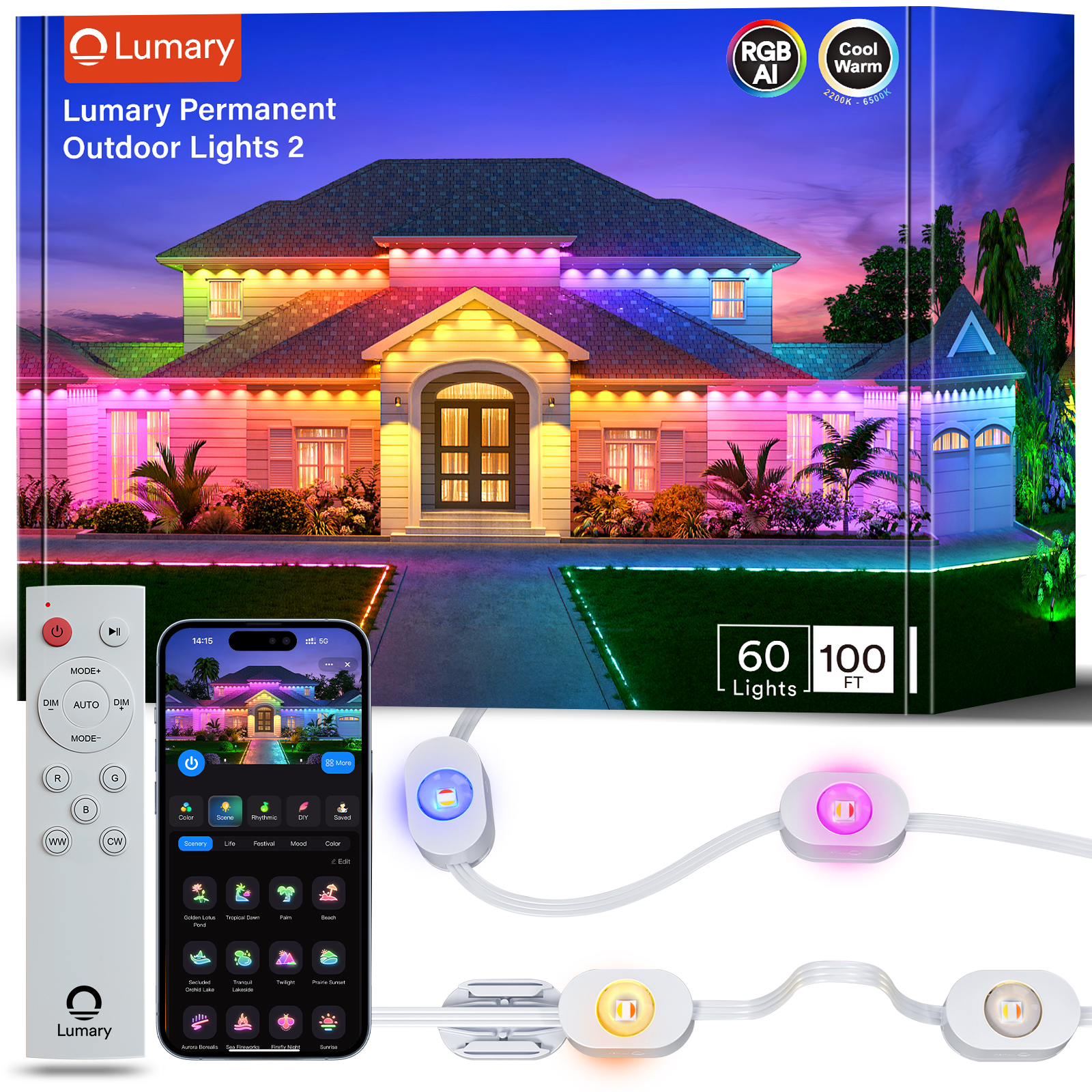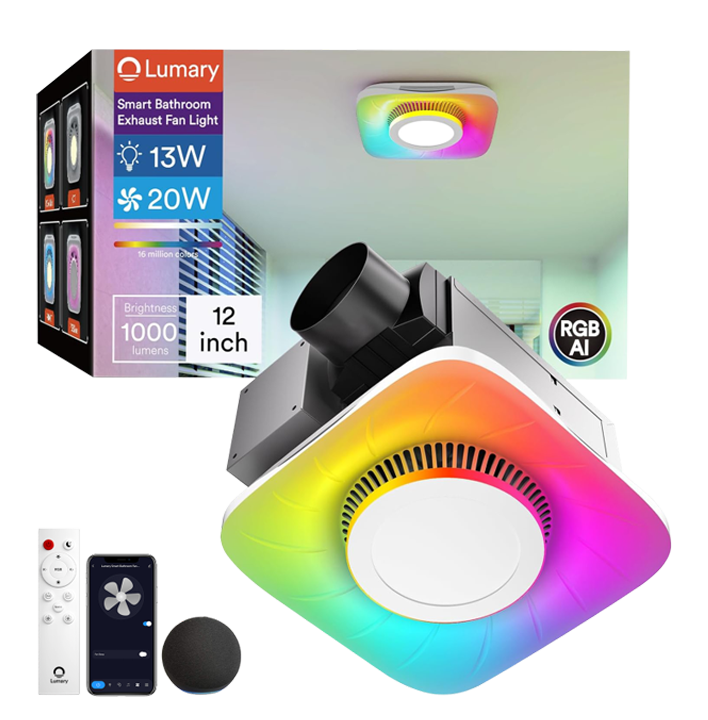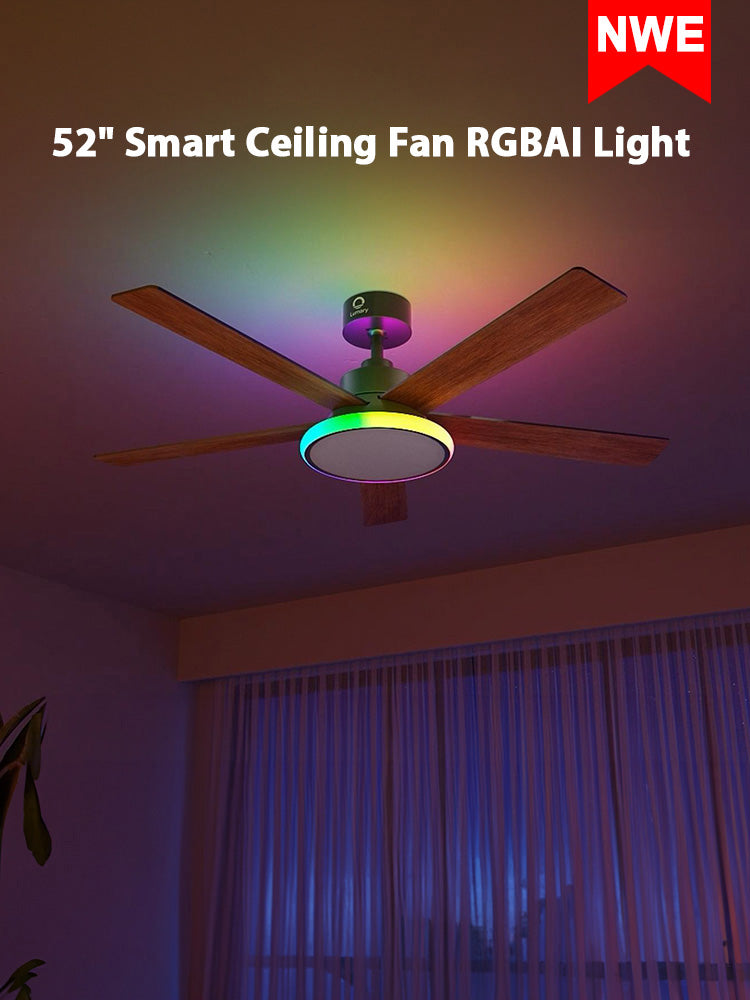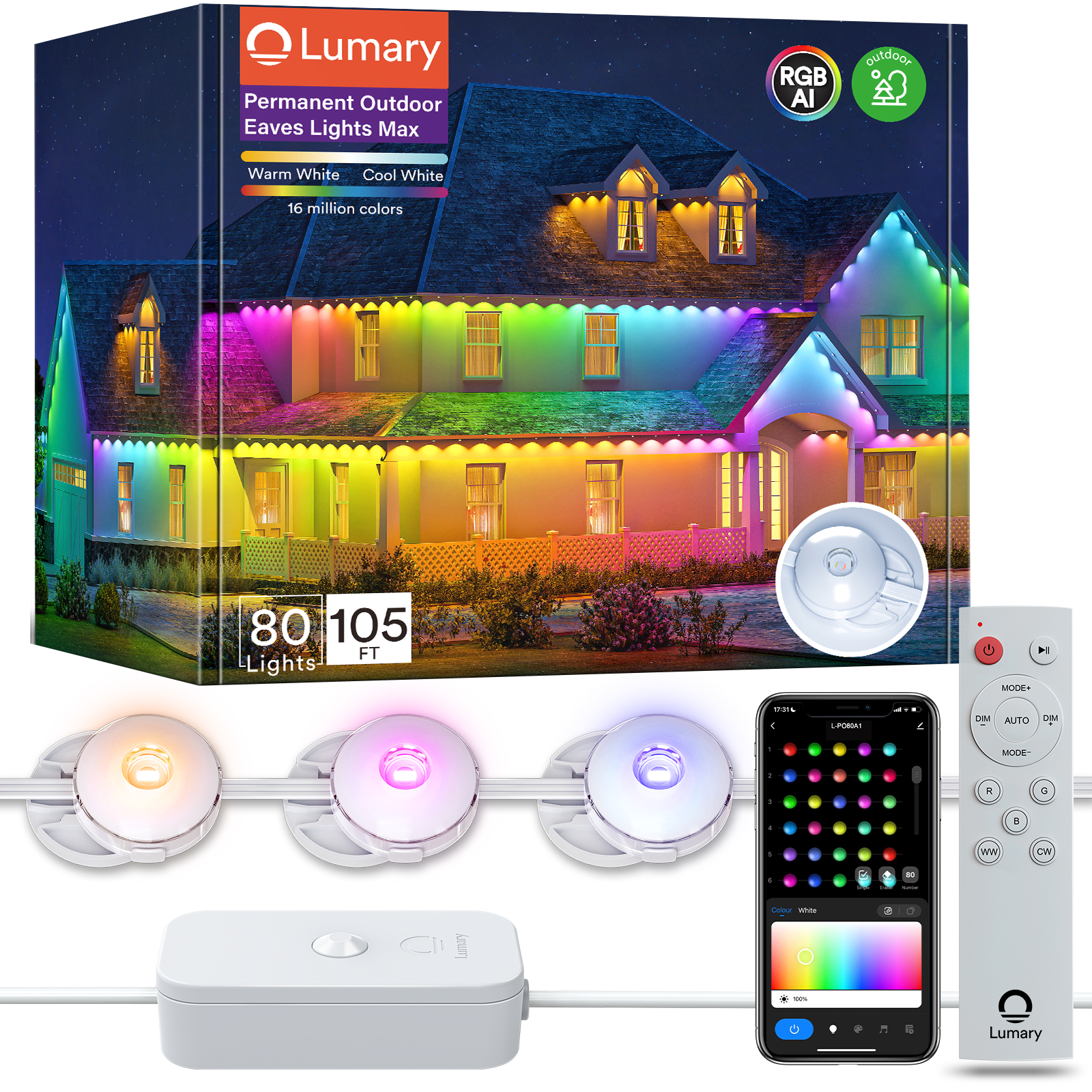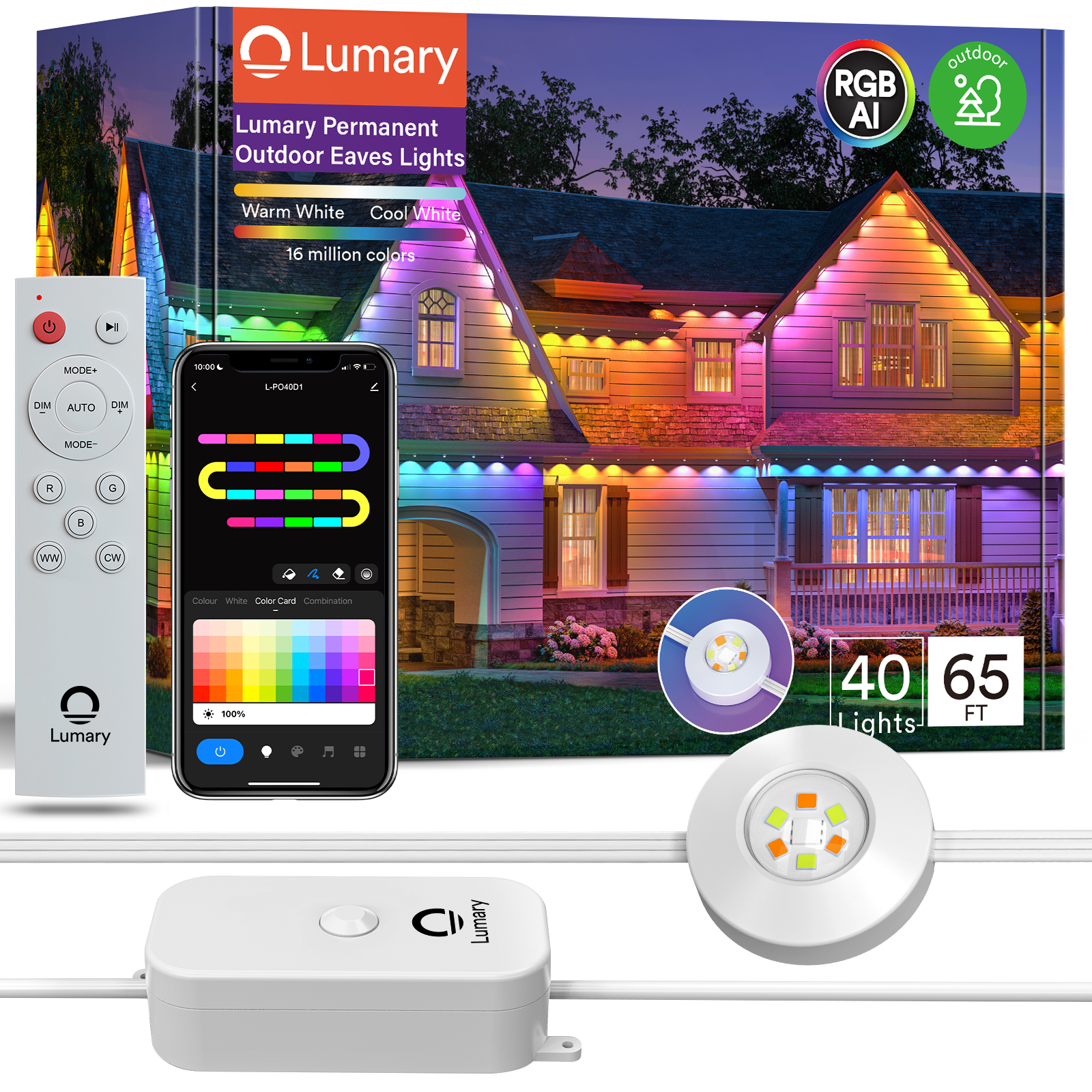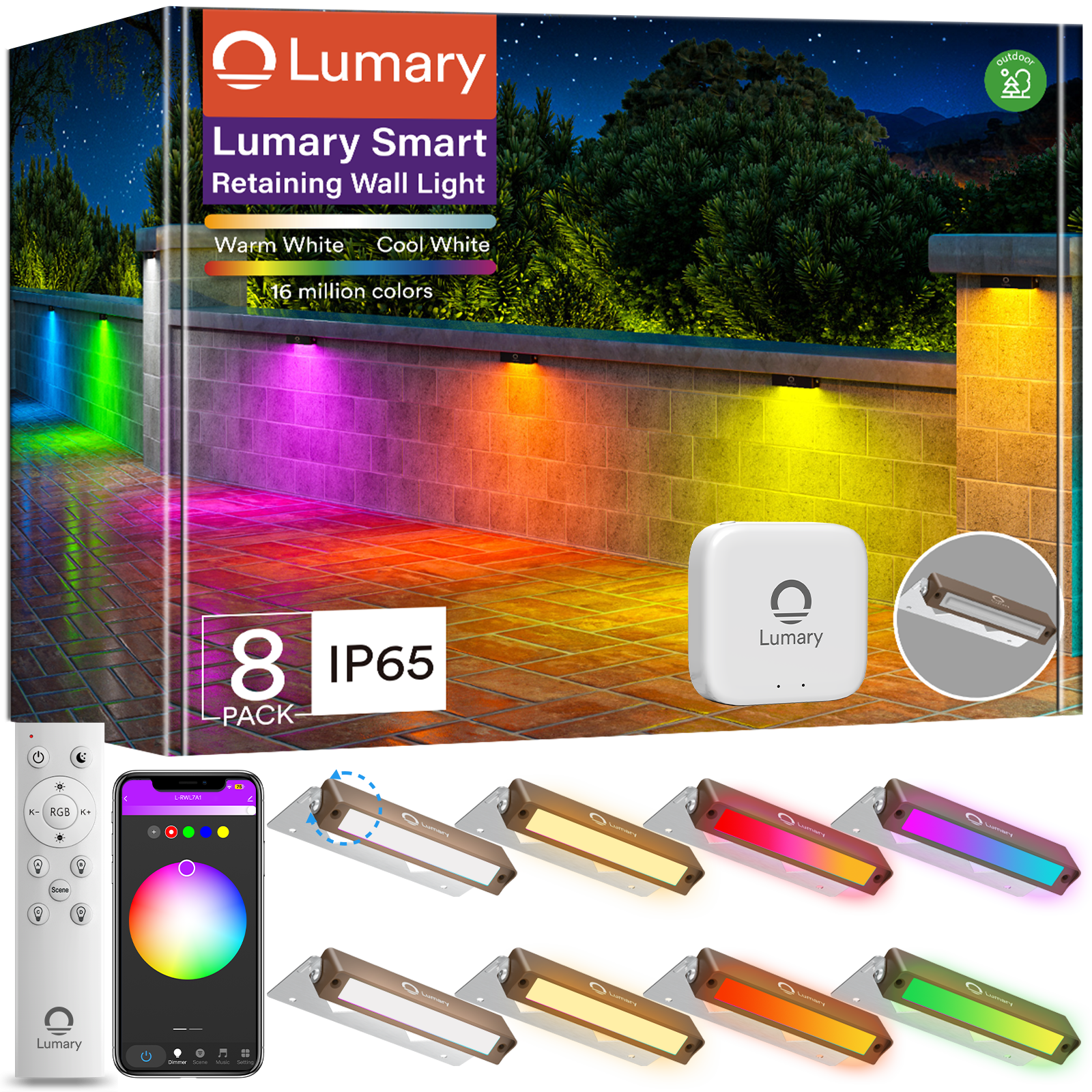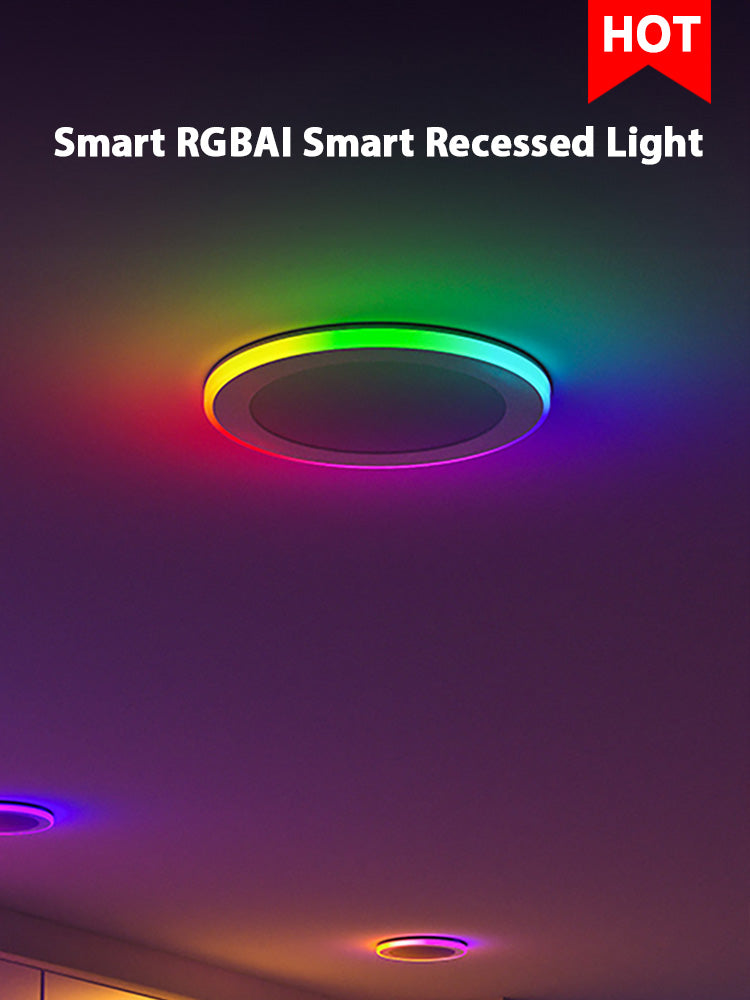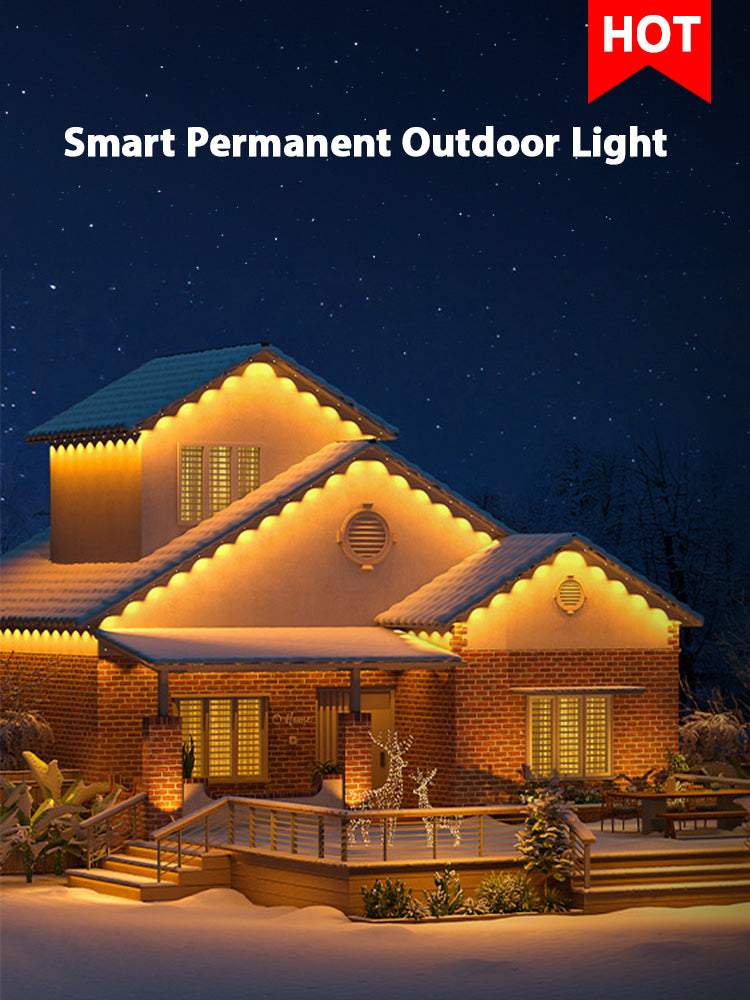Are you thinking about using recessed lights in your home? Many homes in the U.S. have these lights now. There are over 500 million recessed downlights in use. People like them because they save energy, last a long time, and look modern. But, you might have trouble putting them in. The starting price can also be high. Here is a quick look at the good and bad sides:
-
Pros:
-
You save energy with LED technology
-
The design is sleek and saves space
-
They last a long time
-
-
Cons:
-
It can be hard to install them
-
There can be glare or uneven lighting
-
The first cost is higher
-
|
Lighting Type |
Percentage of U.S. Households (2020) |
|---|---|
|
Households using LEDs for most/all indoor lighting |
47% |
|
Households using mostly compact fluorescent bulbs |
12% |
|
Households using incandescent or halogen bulbs |
15% |
You can choose if led recessed lighting is right for you. Think about the pros and cons. Pick what works best for your home.

Key Takeaways
-
LED recessed lights use less energy and last longer than old bulbs. They help you save money and make less trash.
-
These lights look smooth and sit flat with the ceiling. They save space and make your home look new and stylish.
-
Putting in recessed lights can be hard and may need a pro. This helps stop wiring mistakes and makes sure the lights are in good spots.
-
LED recessed lights cost more at first, but you save money on energy. The savings can pay for the lights fast.
-
Picking the right recessed light and planning your setup is important. This stops bad lighting, glare, and air leaks.

Pros of Recessed Lights
Energy Efficiency
When you pick recessed lights with LED technology, you get great energy savings. These downlights use much less power than old bulbs. You can see this in the table below:
|
Light Type |
Approximate Energy Use Compared to Incandescent |
Energy Savings Compared to Incandescent |
Notes |
|---|---|---|---|
|
Incandescent |
Baseline (100%) |
0% |
Least efficient, wastes most energy as heat |
|
CFL |
Uses about 30% of incandescent energy |
Saves about 70% energy |
More efficient than incandescent but less than LED |
|
LED |
Uses about 20-25% of incandescent energy |
Saves about 75-80% energy |
Most efficient, longer lifespan, low heat emission |
If you switch to LED recessed lighting, each fixture uses only 8 to 12 watts. Old bulbs use about 60 watts. That is a big drop in energy use. Your electric bill will go down. You will waste less energy. Here is a quick look at the wattage difference:
|
Lighting Type |
Typical Wattage Range (Watts) |
Energy Consumption Reduction |
Example Equivalent Wattage |
|---|---|---|---|
|
Incandescent Recessed |
40 to 150 (commonly 60W) |
N/A |
60W |
|
LED Recessed |
8 to 12 |
75% to 85% less energy |
10 to 12W |
Using less power helps the environment. You also make less waste. This is good for your wallet and the planet.
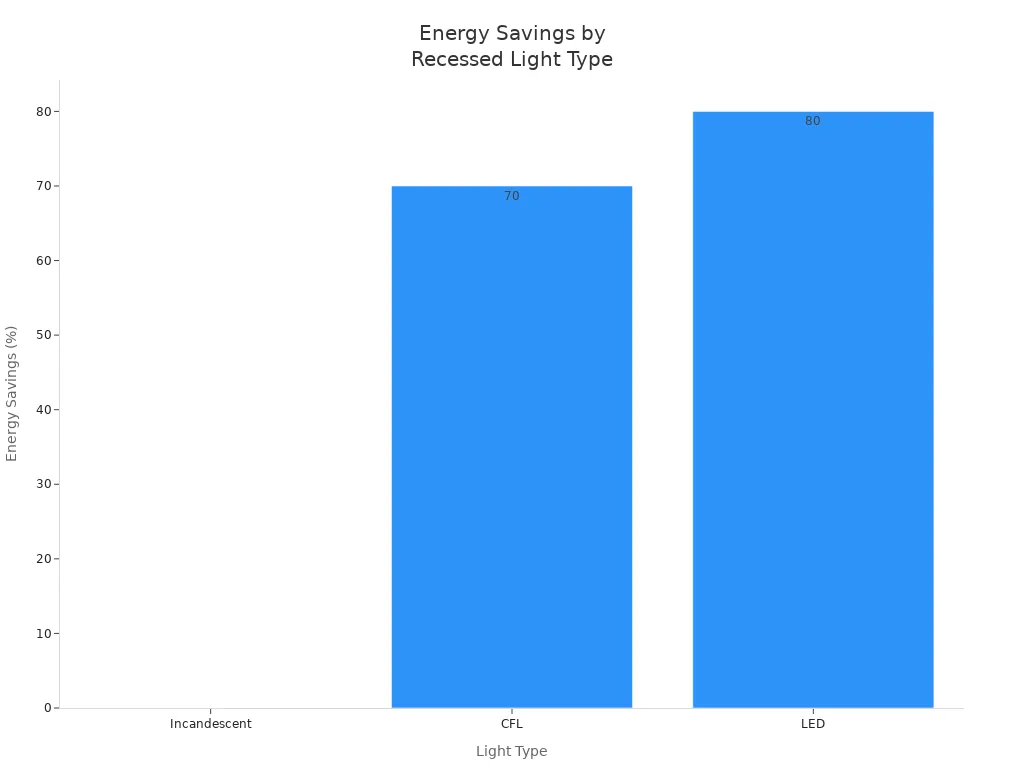
Long Lifespan
A big pro of recessed lights with LED bulbs is how long they last. Most recessed LED downlights shine for 50,000 hours or more. Halogen bulbs last about 2,000 to 4,000 hours. Old bulbs may only last 1,000 hours.
|
Light Type |
Average Lifespan (Hours) |
|---|---|
|
LED |
50,000 or more |
|
Halogen |
2,000 to 4,000 |
|
Incandescent |
750 to 1,000 |
You will not need to change bulbs often. Over ten years, you save money and time. You do not have to climb a ladder much. LEDs do not have fragile filaments. They can handle bumps and shakes better. This long life is why many people pick recessed LED downlights.
Minimal Heat Output
LED recessed downlights stay cool, even after hours of use. Old bulbs, like incandescent, get hot and warm up your room. LEDs give off about 3.4 BTUs per hour. Incandescent bulbs can reach 85 BTUs per hour.
|
Lighting Type |
Heat Output (BTUs per hour) |
|---|---|
|
LED Bulbs |
Approximately 3.4 BTUs |
|
Incandescent Bulbs |
Approximately 85 BTUs |
Low heat means your air conditioner works less in summer. Your room stays cooler. You save more on energy bills. Good recessed LED downlights help keep your home comfy by cutting extra heat.
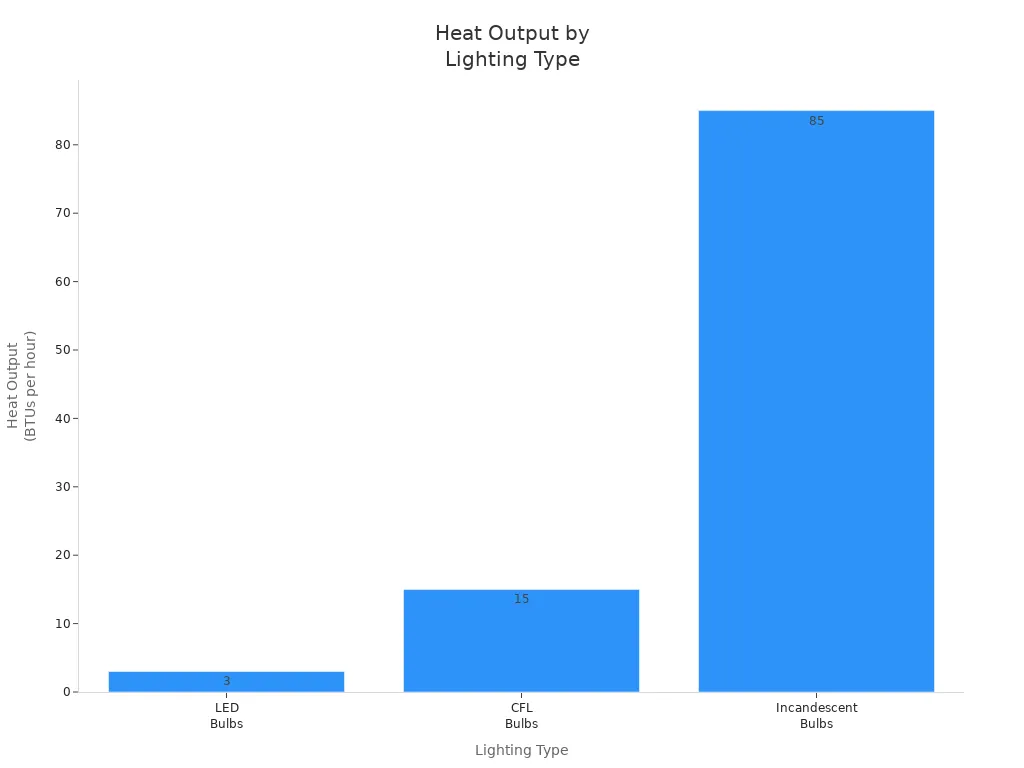
Space-Saving Design
If you have low ceilings or want a neat look, recessed lighting is smart. These downlights sit flat with the ceiling. They do not hang down or take up space. You get more room, which is great for basements, halls, or small rooms.
-
Recessed LED downlights fit into shallow ceilings.
-
Canless recessed lighting works in tight spots and new remodels.
-
Smaller fixtures (like 3-4 inch) give you more choices.
You can space the lights to match your ceiling height. This gives you even, comfy light without glare. This is a top pro of canless recessed lighting. Designers like these fixtures for this reason.
Modern Aesthetics
You want your home to look nice and modern. Recessed lighting gives a sleek, up-to-date feel. The fixtures blend into the ceiling. The room feels open and tidy. This look works in kitchens, living rooms, bathrooms, and outside.
-
Minimalist and trimless designs make the ceiling look smooth.
-
Recessed lights help statement fixtures, like chandeliers, by adding balanced light.
-
You can show off art, architecture, or wood with the right light.
Designers use recessed LED downlights to make spaces look pretty and useful. Rooms feel cozy and modern.
Flexible Lighting Options
Recessed LED downlights give you lots of control over your lights. You can dim them for movies or make them bright for homework. Many models work with smart home systems. You can set schedules, change colors, or use your voice or phone.
|
Feature Category |
Details |
|---|---|
|
Dimming Compatibility |
Works with smart dimmer switches and apps; not always with old dimmers |
|
Smart Control Methods |
App and voice control with smart home assistants |
|
Scheduling & Scenes |
Set custom scenes and schedules for different moods |
|
Remote Control |
Control from anywhere with your phone |
|
Additional Features |
Millions of colors, tunable white light, music sync |
You can also zone your lighting. Use recessed downlights for general light. Add pendants or sconces for tasks or accents. This flexibility is a big pro of can recessed lighting and recessed LED downlights. You get the right light for every activity, from cooking to relaxing.
💡 Tip: Layering recessed lights with other fixtures helps you make depth and set the perfect mood in any room.

Cons of Recessed Lighting
Installation Challenges
Recessed lighting can be tricky to put in. Many people have problems during installation. Here are some common issues:
|
Installation Challenge |
Description |
|---|---|
|
Electrical Hazards |
Wiring mistakes can cause shorts, blown fuses, or fires. |
|
Structural Barriers |
Joists, pipes, or HVAC ducts might block where you want lights. |
|
Aesthetic Issues |
Bad placement or spacing can make your lights look strange. |
|
Permits and Codes |
You might need permits and must follow local codes, which adds steps. |
You should watch out for these problems too:
-
Bad wiring can be unsafe and cause harm.
-
Local rules mean you may need a pro to help.
-
Flickering or buzzing often means wiring or dimmer trouble.
-
Old homes with tough wiring may need an electrician.
-
If you add lots of lights, you must not overload your circuits.
Some mistakes happen a lot:
|
Common Mistake |
Explanation |
|---|---|
|
Incorrect Placement |
If you do not plan, you get shadows and uneven light. |
|
Choosing Wrong Size |
Fixtures that are too big or small change how your room feels. |
|
Overlooking Dimming |
The wrong dimmer can make lights flicker and not last as long. |
⚠️ Tip: To avoid problems, plan your layout, check your wiring, and think about hiring a pro.
Upfront Cost
Recessed lighting can cost more than you expect. LED recessed lights usually cost more than old types. You pay for the fixture and for someone to put it in. Here is what you might pay:
|
Lighting Type |
Fixture Cost Range (USD) |
Installation Cost Range (USD) |
|---|---|---|
|
LED Recessed Lighting |
$15 - $100 |
$160 - $420 |
|
Traditional Recessed |
$10 - $80 |
$150 - $400 |
Each LED fixture can cost $20 to $100. A pro might charge $100 to $250 for each light. If your ceiling is hard to work with, the price goes up. The total cost for LED recessed lighting is usually more than for old lights.
But there is good news. LED recessed lights can save you money fast. You might get your money back in less than a year because of energy savings.
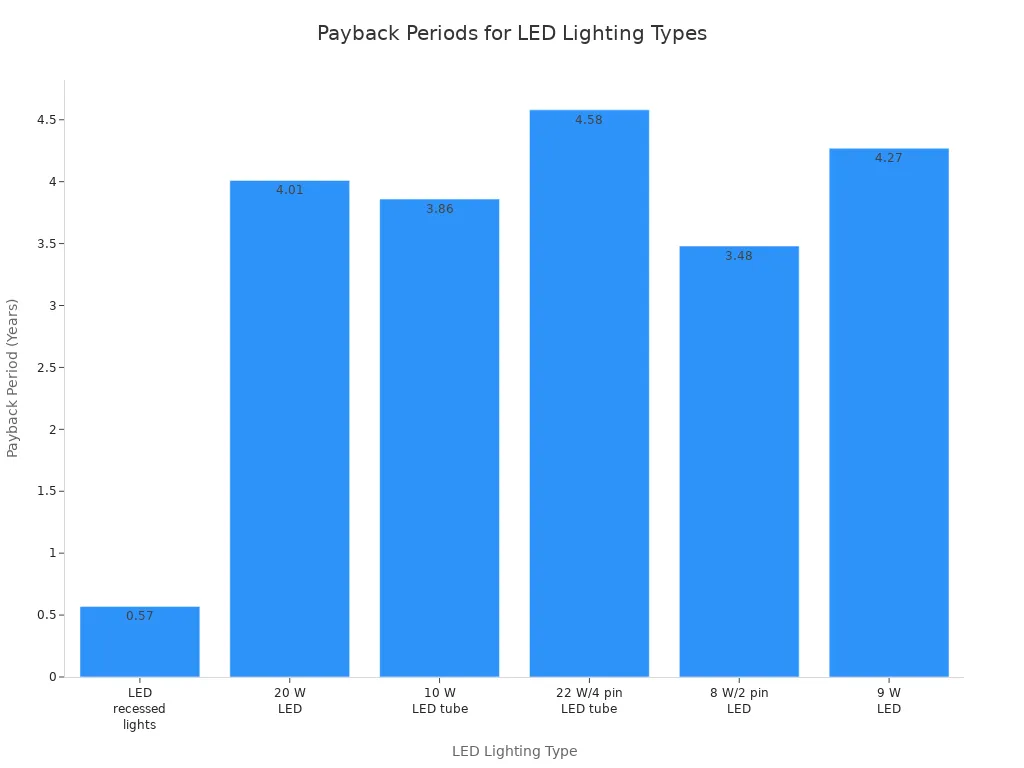
Still, you need to plan for the first cost. If you want to light a whole room, the price can add up fast.
Uneven Lighting & Cave Effect
A big problem with can recessed lighting is uneven light. If you do not space your lights right, you get dark spots or a “cave effect.” This makes rooms feel dark, especially near the walls.
Here are some tips to help:
-
Divide your ceiling height by two to find the best space between lights.
-
Keep lights at least 2 to 3 feet from walls to stop shadows.
-
Use beam angles from 40° to 60° for most rooms.
-
Put lights closer (3 to 4 feet) for places like kitchens.
-
Draw a plan and use a grid for even light.
-
Pick the right trim to control glare and spread.
If you skip these steps, you might see:
-
Flickering lights from loose wires or wrong dimmers.
-
Buzzing from bad wiring.
-
Lights that do not work because of bad switches.
💡 Note: Canless recessed lighting can also give uneven light if you do not plan. Always check your layout before you start.
Color Rendering Issues
Color rendering shows how well your lights show real colors. Halogen and incandescent bulbs have a perfect color rendering index (CRI) of 100. Most LED recessed lights have a CRI in the mid-80s to 90s. This means colors might look dull or strange compared to old bulbs.
Low CRI makes it hard to see true colors. Your walls, art, and furniture might look faded or yellow. High CRI LEDs (95 or more) can fix this, but you need to check before you buy. Also, LED lights keep the same color when dimmed, but halogen bulbs get warmer.
-
Low CRI makes colors look dull or fake.
-
High CRI helps your room look bright and nice.
-
For best results, pick LED recessed lighting with a CRI of 90 or more and a color temperature near 3000K.
Glare and Hotspots
Glare and hotspots are common with canless and regular recessed lights. You might see bright spots or harsh light if you look at the LED chips or if the inside is shiny.
|
Factor Contributing to Glare |
Impact Level |
Common Locations |
|---|---|---|
|
Direct visibility of LED chips through clear openings |
High |
Shallow or flat profiles |
|
Internal reflections from polished aluminum surfaces |
Medium |
Polished aluminum profiles |
Other causes are:
-
Shallow fixtures with small openings focus light and cause glare.
-
Lots of LEDs can still cause glare if the design is bad.
-
Reflections inside the fixture make glare worse, especially on smooth parts.
-
Bad placement and no diffuser make glare stronger.
You can fix glare and hotspots by:
-
Using fixtures with diffusers or covers for soft, even light.
-
Picking the right trim and design.
-
Putting lights in so you cannot see the LED chips.
👀 Tip: Always test your lights before you finish to check for glare or hotspots.
Insulation & Air Leaks
If you do not install recessed lighting right, you can get gaps and air leaks. This is bad for saving energy and comfort. If you use non-ICAT-rated fixtures, you must leave a gap, which lets air escape. If the fixture is not airtight, warm or cool air leaks into your attic or ceiling.
|
Cause of Insulation Gaps and Air Leaks |
Explanation |
|---|---|
|
Use of Non-ICAT-rated Fixtures |
Needs space from insulation, leaving gaps. |
|
Lack of Airtight Housing |
Lets air escape, acting like a chimney. |
|
Failure to Seal Fixture to Ceiling |
Gaps around the fixture let air in and out. |
|
Heat Generated by Fixture |
Pulls warm air into the attic, causing leaks. |
|
Resulting Effects |
Energy loss, moisture, and possible ceiling damage. |
|
Recommended Solutions |
Use ICAT-rated fixtures, seal with caulk or gaskets, and use covers. |
Air leaks from recessed lights can waste as much energy as a 2-inch hole in your ceiling. This means higher bills for heating and cooling. Moisture can build up, causing damage or mold. To stop these problems, always use IC-rated, airtight fixtures and seal them well.
🏠 Note: Upgrading to airtight, IC-rated LED recessed lighting helps keep your home comfy and saves energy.

Choosing LED Recessed Lighting
Room Type & Ceiling Structure
You want your lighting to fit your space. Can recessed lighting works well in many rooms, like kitchens, living rooms, bedrooms, and even bathrooms. You can also use it in hallways, offices, and covered patios. Drop ceilings make it easy to install can recessed lighting because there is extra space above the tiles. If you have a new build or a remodel, you can pick new construction or remodel housings. New construction housings work best when you have open ceilings. Remodel housings fit through small holes in finished ceilings. For tight spots, canless recessed lighting is a smart choice. Ultra-thin downlights slide into shallow ceilings or under joists where other fixtures cannot fit.
💡 Tip: Always check your ceiling joist spacing. Most homes have joists 16 to 24 inches apart. This helps you pick the right size and type of recessed lighting.
Budget Considerations
You want to get the most for your money. Canless recessed lighting usually costs less than can recessed lighting because you do not need a separate housing. Prices can range from $40 to $160 for canless recessed lighting, while can recessed lighting can cost $60 to $240. Some models offer smart features or dimming, which may raise the price. Buying in packs can save you more. Here is a quick look at price ranges:
|
Type/Feature Set |
Price Range |
Notes |
|---|---|---|
|
Canless recessed lighting |
$40 - $160 |
No housing needed |
|
Can recessed lighting |
$60 - $240 |
Separate housing included |
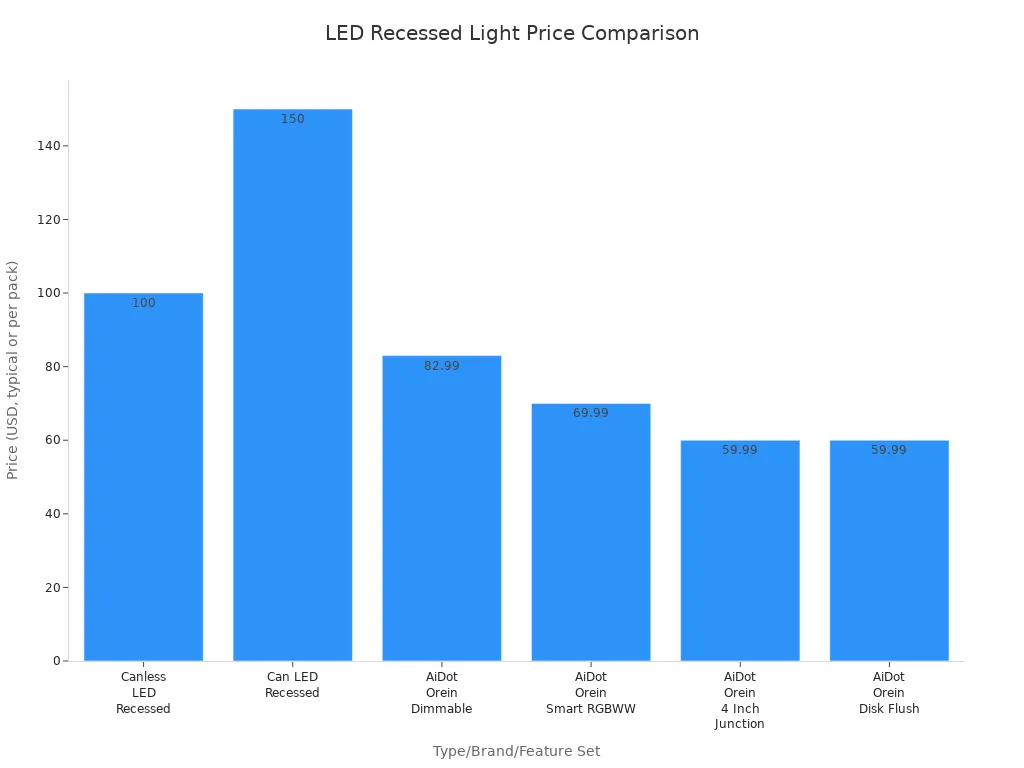
Installation Needs
Think about how easy installation will be. Canless recessed lighting gives you the fastest setup. You just cut a hole and pop the light in. This works great for finished ceilings or places with little space. Can recessed lighting takes more work. You need to fit the housing between joists and sometimes deal with insulation. If your ceiling has insulation, use IC-rated fixtures to stay safe. Air-tight housings help stop heat loss. Remodel housings are best if you cannot reach above the ceiling. Always match the housing type to your ceiling and insulation.
⚠️ Note: Pick canless recessed lighting for easy installation in tight spaces. Use can recessed lighting if you want a more traditional setup or need to match existing fixtures.
Lighting Goals & Style
What do you want your lights to do? If you want a clean, modern look, canless recessed lighting blends right into the ceiling. You can use it for general light, task lighting, or to highlight art. Can recessed lighting gives you more trim options and works well if you want to match older fixtures. Think about the types of recessed lighting that fit your style. You can choose dimmable or smart options for more control. Plan your layout to avoid shadows and get even light. Mix recessed led downlights with other lights for the best effect.
🏠 Remember: Your lighting should match your needs and style. Test a few fixtures before you buy a whole set.
Recessed LED Downlights: What to Know
Canless vs. Can Lights
You might wonder if you should pick canless recessed lighting or stick with can recessed lighting. Here’s what you need to know:
-
Can recessed lighting needs a metal housing, or “can,” inside your ceiling. This housing holds the wiring and bulb. You need enough space above the ceiling for the can. Sometimes, you have to move pipes or wires to fit it in.
-
Canless recessed lighting skips the housing. You install these downlights right into the ceiling. They connect straight to your electrical box. You only need to cut a hole, check the wires, and snap the fixture in place.
-
Canless recessed lighting works great in tight spaces or where you have little ceiling depth. It also helps reduce air leaks and heat loss.
-
Can recessed lighting takes more time and planning. You need to think about ceiling structure and insulation.
If you want a quick, simple install, canless recessed lighting is usually the way to go.
Dimming & Controls
You can control the mood in your room with dimming features. Most recessed led downlights support dimming, but you need to use the right dimmer switch. Some older dimmers do not work well with led downlights. If you use the wrong dimmer, you might see flickering or buzzing.
Many canless recessed lighting options now work with smart home systems. You can set schedules, change colors, or use your phone to control the lights. Always check if your downlights and dimmers match before you buy.
💡 Tip: Use LED-compatible dimmers for smooth, flicker-free control.
Maintenance Tips
Recessed downlights need a little care to keep working well. Here are some common issues and how you can fix them:
|
Maintenance Issue |
Causes |
Solutions |
|---|---|---|
|
Flickering Lights |
Loose wires, wrong dimmer, power changes |
Tighten wires, use LED dimmer, steady voltage |
|
Overheating |
Wrong bulb wattage, poor ventilation |
Use correct bulbs, improve airflow |
|
Sagging Trim |
Damaged springs |
Replace springs, reinstall trim |
|
Lights Turning Off |
Overheating, insulation contact |
Check insulation, use IC-rated fixtures |
You should check your downlights every few months. Make sure the trim sits tight and the lights work as they should. If you see blinking or the lights turn off, check the wiring and the type of bulbs you use. Buying all your led downlights from the same batch helps keep the color even.
🛠️ Note: Regular checks help your canless recessed lighting last longer and keep your home safe.
You have seen that LED recessed lights offer energy savings, a modern look, and a long lifespan. You might face higher upfront costs or tricky installation. Your best choice depends on your space and what matters most to you. Check out these key factors before you decide:
|
Key Factor |
What to Think About |
|---|---|
|
Room Size |
Bigger rooms need more lights |
|
Ceiling Height |
Higher ceilings need brighter fixtures |
|
Installation Type |
Canless is easier for remodels |
|
Lighting Purpose |
Task, accent, or general lighting |
|
Budget |
Balance cost with long-term savings |
Pick what fits your style and needs. You can create a space that feels just right for you!
FAQ
Can you install LED recessed lights yourself?
You can install them if you feel comfortable with basic wiring and tools. Always turn off the power first. If you feel unsure, hire a licensed electrician for safety.
Do LED recessed lights work with dimmer switches?
Most LED recessed lights work with dimmers, but you need a dimmer made for LEDs. If you use the wrong dimmer, your lights might flicker or buzz.
How many recessed lights do you need in a room?
A good rule is to space lights about half the ceiling height apart. For example, with an 8-foot ceiling, place lights 4 feet apart. Adjust for your room’s size and shape.
Are LED recessed lights safe for insulated ceilings?
Yes, if you use IC-rated and airtight fixtures. These lights touch insulation safely and help prevent air leaks. Always check the product label before you buy.
Can you change the color temperature of LED recessed lights?
Some LED recessed lights let you pick the color temperature. You can switch from warm to cool white using a switch or remote. Check the product details to see if this feature is included.

